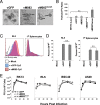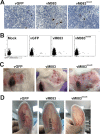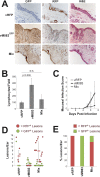Myxoma Virus M083 Is a Virulence Factor Which Mediates Systemic Dissemination
- PMID: 29343569
- PMCID: PMC5972901
- DOI: 10.1128/JVI.02186-17
Myxoma Virus M083 Is a Virulence Factor Which Mediates Systemic Dissemination
Abstract
Poxviruses are large, DNA viruses whose protein capsid is surrounded by one or more lipid envelopes. Embedded into these lipid envelopes are three conserved viral proteins which are thought to mediate binding of virions to target cells. While the function of these proteins has been studied in vitro, their specific roles during the pathogenesis of poxviral disease remain largely unclear. Here we present data demonstrating that the putative chondroitin binding protein M083 from the leporipoxvirus myxoma virus is a significant virulence factor during infection of susceptible Oryctolagus rabbits. Removal of M083 results in a reduced capacity of virus to spread beyond the regional lymph nodes and completely eliminates infection-mediated mortality. In vitro, removal of M083 results in only minor intracellular replication defects but causes a significant reduction in the ability of myxoma virus to spread from infected epithelial cells onto primary lymphocytes. We hypothesize that the physiological role of M083 is therefore to mediate the spread of myxoma virus onto rabbit lymphocytes, allowing these cells to disseminate virus throughout infected rabbits.IMPORTANCE Poxviruses represent both a class of human pathogens and potential therapeutic agents for the treatment of human malignancy. Understanding the basic biology of these agents is therefore significant to human health in a variety of ways. While the mechanisms mediating poxviral binding have been well studied in vitro, how these mechanisms impact poxviral pathogenesis in vivo remains unclear. The current study advances our understanding of how poxviral binding impacts viral pathogenesis by demonstrating that the putative chondroitin binding protein M083 plays a critical role during the pathogenesis of myxoma virus in susceptible Oryctolagus rabbits by impacting viral dissemination through changes in the transfer of virions onto primary splenocytes.
Keywords: binding proteins; myxoma virus; pathogenesis; virulence factor.
Copyright © 2018 American Society for Microbiology.
Figures







References
-
- Knipe DM, Howley PM, Cohen JI, Griffin DE, Lamb RA, Martin MA, Racaniello VR, Roizman B (ed). 2013. Fields virology, 6th ed Lippincott Williams & Wilkins, Philadelphia, PA.
Publication types
MeSH terms
Substances
Grants and funding
LinkOut - more resources
Full Text Sources
Other Literature Sources

